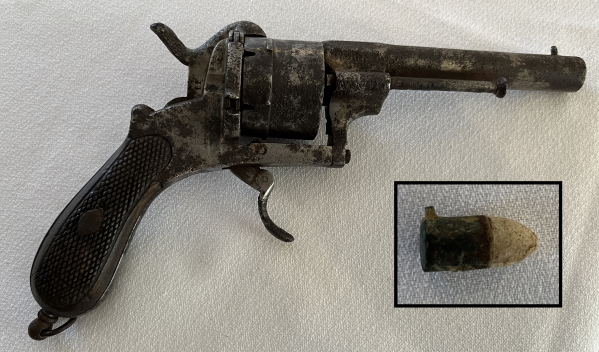
Find out about the Lefaucheux 12mm Pinfire Revolver and pinfire cartridge on display by clicking/pressing the play button. Scroll down to view the images. After the images there is a video describing a Lefaucheaux pinfire revolver. You can follow along with the audio's script at the end of the page.

Lefaucheux 12 mm Pinfire Revolver with Pinfire Cartridge Inset
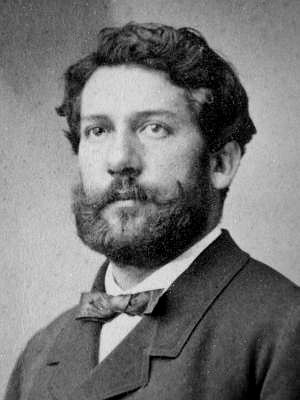
Casimir Lefaucheux
Schematic of a Pinfire Cartridge
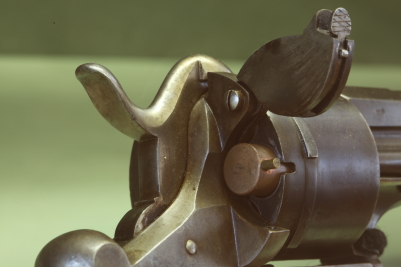
Detail of a Lefaucheux Pinfire Revolver. Notice the pin protruding from the cartridge
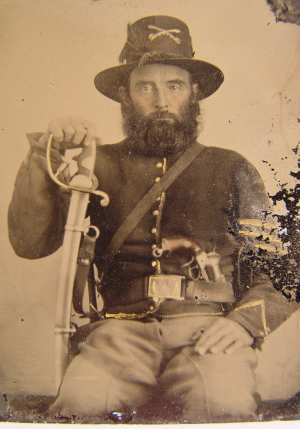
Unidentified soldier in Union cavalry uniform and Hardee hat with European import saber and French LeFaucheux pinfire revolver
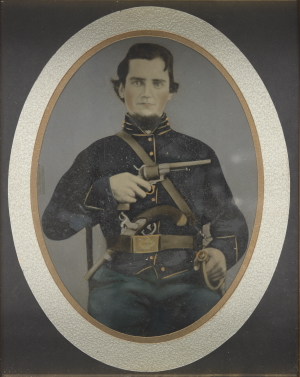
Private Silas York of Co. F, 5th Illinois Cavalry Regiment, with single shot percussion pistol, Lefaucheux revolver, and sword
This is a short YouTube video (produced by Valmont Firearms) demonstrating a Lefaucheux Pinfire Revolver.
The revolver on display was discovered by members of the William Adams family on their farm at Byram’s Ford in the late 1800s. While repairing a broken barn wall, the family found the revolver behind the wall and wrapped inside a gray Confederate shell jacket. Mice had shredded the jacket and gnawed on the gun grips. The pistol itself is highly corroded and most of its markings are no longer legible, but it’s likely a Lefaucheux Model 1854 12 mm pinfire revolver. In front of the pistol in the display case is one of its cartridges, recovered from the former Adams’ farm in the Meadow area at Byram’s Ford while the land was still being farmed.
In 1835, French gunsmith Casimir Lefaucheux was granted a French patent for a self-contained, pinfire cartridge. Pulling the trigger causes the gun’s hammer to strike the pin, driving it into the primer to ignite the black powder. Lefaucheux’s original design was improved by Benjamin Houllier who patented an all metallic pinfire cartridge in 1846.
Working alongside his father, Eugene learned everything his father could teach him and inherited the business when Casimir died in 1852. To learn modern manufacturing techniques, Eugene Lefaucheux moved to Liege in Belgium while his mother continued to operate their gun shop. A year later, Eugene returned home with plans to modernize his Paris gun shop.
While in Belgium, Eugene learned all he could about percussion revolvers. He used that knowledge to design and produce a revolvers that used the Lefaucheux cartridge. It was destined to become the most widely used military sidearm in Europe for many, many years. Lefaucheux was granted a French and English patent for this revolver in 1854. Thus, it came to be known as a Model 1854 Lefaucheux Pinfire Revolver. After extensive testing, France’s Council of Naval Armaments adopted the Model 1854 on March 4, 1858, as the official sidearm of the Navy. The French government required all military armaments to be manufactured at the Imperial Arms Factory. Once this happened, the sidearm was officially designated as “Navy Revolver Model 1858). But Eugene Lefaucheux was still permitted manufacture and sell his sidearms to foreign governments and private parties.
Which brings us back to the 12 mm pinfire revolver on display. Note that there is a folding trigger with no trigger guard. This revolver is double-action, meaning pulling the trigger cocks the hammer. The rod under the barrel was used to eject spent cartridges so they could be reloaded.
Along with those of other countries, the US Army Ordnance Department had paid attention when word came out that France had adopted the Lefaucheux pinfire revolver.
When the Civil War, the US Army found it necessary to supplement arms procurement using foreign manufacturers. In July 1861 on behalf of US Secretary of War Simon Cameron, New York State Militia Colonel George L. Schuyler purchased 10,000 Model 1854 Pinfire Revolvers (@$12.50) and 200,000 rounds of pinfire cartridges ($17.45 per thousand) from Eugene Lefaucheux. In all the US War Department purchased more than 11,800 of the revolvers and over 2 million pinfire cartridges. Most of the cartridges purchased were manufactured in the United States. The French revolver was the fourth most numerous revolver used during the Civil War.
Well over 3,000 of the revolvers were used in the western theaters of the war. Units issued pinfire revolvers included the 2d Kansas Cavalry, 5th Kansas Cavalry, 6th Kansas Cavalry, 2d Colorado Cavalry, 1st, 4th, 7th, 8th, and 11th Missouri Cavalry, as well as the 9th Missouri State Militia Cavalry. The 3d Wisconsin Cavalry was also issued these revolvers.
Although there are no surviving Confederate purchase records for Lefaucheux pinfire revolvers, but many were in use during the war. One reason for lack of purchase records was intentional mislabeling of shipments to skirt the US blockade of the Confederacy. Confederate arsenal records have been found indicating 50,000 and 45,000 rounds of 12 mm pinfire cartridges in inventory so it’s clear there were significant numbers of the revolvers being used by Confederates.
As with all metallic cartridge-based firearms, they became useless when the shooter ran out of cartridges. But some of the revolvers used during the Civil War could use what was called a “chimney” adaptor. It was a reusable metal tube that could be filled with powder and then a lead ball pressed into the tube. The adaptor was then inserted into the revolver’s cylinder and a percussion cap place on the adaptor’s “pin.”
Coggins, Jack. Arms and Equipment of the Civil War. Wilmington, NC: Broadfoot Pub. Co., 1990.
Chris C. Curtis. Systeme Lefaucheux: Continuing the Study of Pinfire Cartridge Arms Including Their Role in the American Civil War. Santa Ana, CA: Armslore Press, 2002.
Walter, John. Weapons of the Civil War Cavalryman. Kindle., 2020.